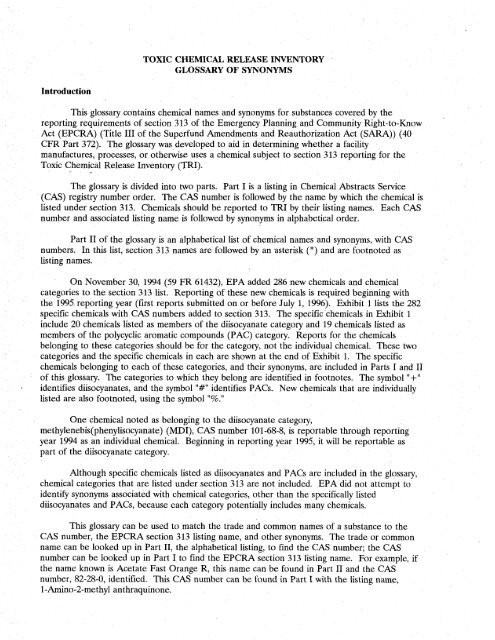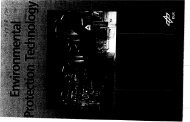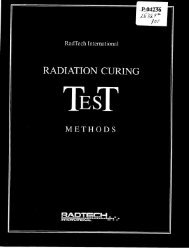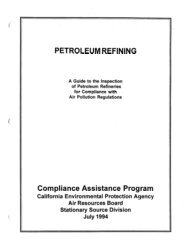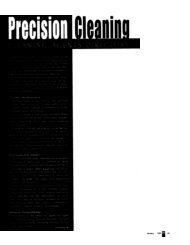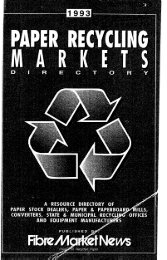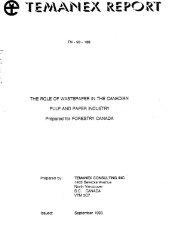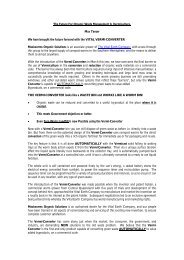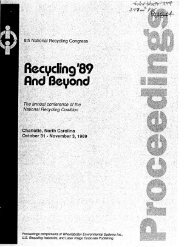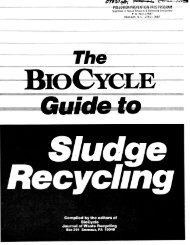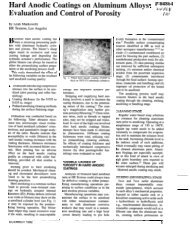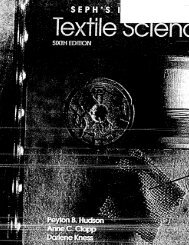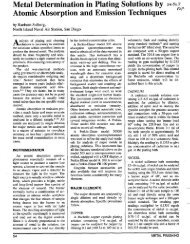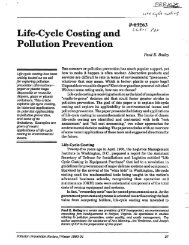For Chemicals Listed Under Section 313 of the ... - P2 InfoHouse
For Chemicals Listed Under Section 313 of the ... - P2 InfoHouse
For Chemicals Listed Under Section 313 of the ... - P2 InfoHouse
You also want an ePaper? Increase the reach of your titles
YUMPU automatically turns print PDFs into web optimized ePapers that Google loves.
Introduction<br />
TOXIC CHEMICAL RELEASE INVENTORY<br />
GLOSSARY OF SYNONYMS<br />
This glossary contains chemical names and synonyms for substances covered by <strong>the</strong><br />
reporting requirements <strong>of</strong> section <strong>313</strong> <strong>of</strong> <strong>the</strong> Emergency Planning and Community Right-to-Know<br />
Act (EPCRA) (Title I11 <strong>of</strong> <strong>the</strong> Superfund Amendments and Reauthorization Act (SARA)) (40<br />
CFR Part 372). The glossary was developed to aid in determining whe<strong>the</strong>r a facility<br />
manufactures, processes, or o<strong>the</strong>rwise uses a chemical subject to section <strong>313</strong> reporting for <strong>the</strong><br />
Toxic Chemical Release Inventory (TRI).<br />
The glossary is divided into two parts. Part I is a listing in Chemical Abstracts Service<br />
(CAS) registry number order. The CAS number is followed by <strong>the</strong> name by which <strong>the</strong> chemical is<br />
listed under section <strong>313</strong>. <strong>Chemicals</strong> should be reported to TRI by <strong>the</strong>ir listing names. Each CAS<br />
number and associated listing name is followed by synonyms in alphabetical order.<br />
Part I1 <strong>of</strong> <strong>the</strong> glossary is an alphabetical list <strong>of</strong> chemical names and synonyms, with CAS<br />
numbers. In this list, section <strong>313</strong> names are followed by an asterisk (*) and are footnoted as<br />
listing names.<br />
On November 30, 1994 (59 FR 61432), EPA added 286 new chemicals and chemical<br />
categories to <strong>the</strong> section <strong>313</strong> list. Reporting <strong>of</strong> <strong>the</strong>se new chemicals is required beginning with<br />
<strong>the</strong> 1995 reporting year (first reports submitted on or before July 1, 1996). Exhibit 1 lists <strong>the</strong> 282<br />
specific chemicals with CAS numbers added to section <strong>313</strong>. The specific chemicals in Exhibit 1<br />
include 20 chemicals listed as members <strong>of</strong> <strong>the</strong> diisocyanate category and 19 chemicals listed as<br />
members <strong>of</strong> <strong>the</strong> polycyclic aromatic compounds (PAC) category. Reports for <strong>the</strong> chemicals<br />
belonging to <strong>the</strong>se categories should be for <strong>the</strong> category, not <strong>the</strong> individual chemical. These two<br />
categories and <strong>the</strong> specific chemicals in each are shown at <strong>the</strong> end <strong>of</strong> Exhibit 1. The specific<br />
chemicals belonging to each <strong>of</strong> <strong>the</strong>se categories, and <strong>the</strong>ir synonyms, are included in Parts I and I1<br />
<strong>of</strong> this glossary. The categories to which <strong>the</strong>y belong are identified in footnotes. The symbol "+I'<br />
identifies diisocyanates, and <strong>the</strong> symbol "#" identifies PACs. New chemicals that are individually<br />
listed are also footnoted, hsing <strong>the</strong> symbol "%."<br />
One chemical noted as belonging to <strong>the</strong> diisocyanate category,<br />
methylenebis(pheny1isocyanate) (MDI), CAS number 101-68-8, is reportable through reporting<br />
year 1994 as an individual chemical. Beginning in reporting year 1995, it will be reportable as<br />
part <strong>of</strong> <strong>the</strong> diisocyanate category.<br />
Although specific chemicals listed as diisocyanates and PACs are included in <strong>the</strong> glossary,<br />
chemical categories that are listed under section <strong>313</strong> are not included. EPA did not attempt to<br />
identify synonyms associated with chemical categories, o<strong>the</strong>r than <strong>the</strong> specifically listed<br />
diisocyanates and PACs, because each category potentially includes many chemicals.<br />
This glossary can be used to match <strong>the</strong> trade and common names <strong>of</strong> a substance to <strong>the</strong><br />
CAS number, <strong>the</strong> EPCRA section <strong>313</strong> listing name, and o<strong>the</strong>r synonyms. The trade or common<br />
name can be looked up in Part 11, <strong>the</strong> alphabetical listing, to find <strong>the</strong> CAS number; <strong>the</strong> CAS<br />
number can be looked up in Part I to find <strong>the</strong> EPCRA section <strong>313</strong> listing name. <strong>For</strong> example, if<br />
<strong>the</strong> name known is Acetate Fast Orange R, this name can be found in Part I1 and <strong>the</strong> CAS<br />
number, 82-28-0, identified. This CAS number can be found in Part I with <strong>the</strong> listing name,<br />
1-Amino-2-methyl anthraquinone.


